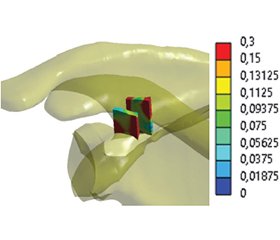Журнал «Травма» Том 26, №3, 2025
Вернуться к номеру
Напружено-деформований стан надплечово-ключичного суглоба при ушкодженні надплечово-ключичних зв’язок та фіксації hook plate (клініко-експериментальне дослідження)
Авторы: Кваша В.П. (1), Левицький А.Ф. (1), Чорний В.С. (1), Лиходій В.В. (1), Карпінський М.Ю. (2), Яресько О.В. (2)
(1) - Національний медичний університет імені О.О. Богомольця, м. Київ, Україна
(2) - ДУ «Інститут патології хребта та суглобів імені професора М.І. Ситенка НАМН України», м. Харків, Україна
Рубрики: Травматология и ортопедия
Разделы: Клинические исследования
Версия для печати
Актуальність. Питома частка вивихів акроміального кінця ключиці становить до 26 % серед травматичних вивихів апарата руху та опори та до 10 % серед травматичних уражень у ділянці плечового поясу. У світовій практиці потреба у фіксації акроміального кінця ключиці реалізується в 47 % випадків шляхом використання hook platе. Однак використання цієї конструкції поряд з перевагами має суттєві недоліки, як-от біль у плечі, руйнація кісткової тканини, особливо в ділянці надплечового відростка лопатки, та субакроміальний конфлікт. Мета: встановити взаємозв’язок негативних наслідків та конструктивних особливостей hook platе шляхом вивчення напружено-деформованого стану надплечово-ключичного суглоба при ушкодженні надплечово-ключичного статичного зв’язкового комплексу. Матеріали та методи. Експериментальна частина базується на дослідженні скінченно-елементних моделей надплечово-ключичного суглоба в нормі, при пошкодженні надплечово-ключичних стабілізаторів та при фіксації акроміального кінця ключиці hook platе. Клінічний матеріал базується на аналізі результатів лікування 36 пацієнтів, у яких було діагностовано поєднане ушкодження lig. acromioclavicularе inferior та lig. acromioclavicularе superior і фіксація hook plate. Результати. При ушкодженні обох зв’язок комплексу hook plate дозволяє знизити рівень напружень у ключиці практично до норми, але напруження на дзьобоподібному відростку лопатки залишаються на досить високому рівні — 90,0 МПа). Також значні напруження виникають на акроміальному відростку — 55,3 МПа та по краю виїмки лопатки — 54,2 МПа. При цьому напруження самої пластини підвищуються до 433,3 МПа, що досить близько до межі міцності матеріалу, з якого вона виготовлена. Висновки. При ушкодженні обох зв’язок надплечово-ключичного комплексу hook plate дозволяє знизити рівень напружень у ключиці практично до норми, але напруження на дзьобоподібному відростку лопатки залишаються на досить високому рівні. Також значні напруження виникають на акроміальному відростку та по краю виїмки лопатки, що пояснює розвиток ерозій і відповідно субакроміального конфлікту, а це негативно впливає на результати лікування.
Background. The specific proportion of dislocations of the acromial end of the clavicle is up to 26 % of traumatic dislocations of the locomotor system and up to 10 % of traumatic lesions in the shoulder girdle. In world practice, the need to fix the acromial end of the clavicle is realized by using hook plates in 47 % of cases. However, this design, along with its advantages, has significant disadvantages, the most significant of them are shoulder pain, bone destruction, especially in the area of the acromion, and subacromial conflict. Objective: to establish the relationship between the negative consequences and the design features of the hook plate by investigating the stress-strain state of the acromioclavicular joint in case of damage to the acromioclavicular static ligament complex. Materials and methods. The experimental part is based on the study of finite element models of the supraclavicular joint in normal conditions, with damage to the acromioclavicular stabilizers, and with fixation of the acromial end of the clavicle with a hook plate. The clinical material is based on the analysis of the treatment outcomes in 36 patients who were diagnosed with combined damage to the lig. acromioclavicularе inferior and lig. acromioclaviculare superior and hook plate fixation. Results. When both ligaments of the complex are damaged, the hook plate allows you to reduce the stress level in the clavicle almost to the normal level, but the stress on the coracoid process remains at a fairly high level of 90.0 MPa. Also, significant stresses occur on the acromion — 55.3 MPa and on the edge of the scapular notch — 54.2 MPa. At the same time, the stresses in the plate itself increase to 433.3 MPa, which is quite close to the strength limit of the material from which it is made. Conclusions. When both ligaments of the acromioclavicular complex are damaged, the hook plate allows you to reduce the level of stress in the clavicle almost to the normal level, but the stress on the coracoid process remains at a fairly high level. Also, significant stresses occur at the acromial process and along the edge of the scapular notch, which explains the development of erosions and, accordingly, subacromial conflict, which negatively affects treatment outcomes.
надплечово-ключичний суглоб; статичні стабілізатори; спосіб фіксації hook platе
acromioclavicular joint; static stabilizers; hook plate fixation method

